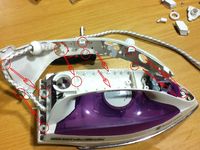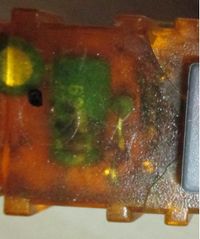Steam Irons
The first challenge with a modern steam irons may be to disassemble it. Unfortunately the repair options can be limited, nevertheess some of what can be attempted is described here.
Summary
Steam irons are regularly seen at Restart parties. They can be challenging to open, and as with any appliance which mixes water and electricity the fault can often be due to a failure, ultimately, to keep them sufficiently apart.
Disassembly
Usually there will be one or two easily accessible screws at the back of the handle of the iron. These typically release a cover providing access to the cable connections. If the problem is a worn cable, hopefully this may be all the disassembly required.
Another screw or screws near the front may be hidden for example under the steam button, but even after removing these the handle cover can be tricky to remove. Often there will be a series of clips down the sides, but this may not be all. In the iron illustrated there was another clip to be released on the top just forward of the cable which required the whole of the top cover to be pushed forward.
With the top cover off it should be possible to find the screws which release the whole of the plastic top, in order to access the thermostat etc. and (if not already accessible) to replace the mains lead.
On reassembly, ensure that any tubes associated with the water reservoir and steam delivery are properly connected.
Specific Faults
You should be able to diagnose electrical faults with a multimeter. Trace electrical connectivity from the mains plug live pin through the flex, the thermostat, the element and back through the flex to the mains plug neutral pin. A 240V 750W iron will have an element with a resistance of around 75Ω.
Worn Flex
Because irons are moved around a lot, this causes strain on the mains lead. One or more of the conductors can break, usually close to the iron body. Locating the break may be tricky, although usually it will be close to the body and can often be felt by bending the flex conductors individually.
You can cut the existing flex back to before the break then reconnect it, but for safety and lengevity you will probably do better by replacing it with a compatible heat-resistant flex. Seartch online for cotton covered iron flex, or try a local domestic appliance repair shop if you have one.
Thermostat
The thermostat switches the element off when the iron gets up to temperature and back on as it cools down a bit. Usually it consists of a pair of contacts, one of which is a bimetallic strip which bends away from the other when it heats up. The distance between the contacts is adjusted by a threaded shaft attached to the temperature control knob.
If the electrical continuity is otherwise good and the element shows the correct resistance, but the iron won't heat up, try cleaning the thermostat contacts and checking that they do actually make electrical contact when they come together.
In addition to the thermostat, there may be a thermal cutout switch to prevent excessive overheating should the thermostat get stuck on. This may or may not be resettable. You can test it for continuity with a multimeter.
No Steam
If the iron is heating up but isn't producing steam, this is almost certainly a mechanical problem, usually caused by limescale: descale it.
Another possibility is that there is a hole which allows air into the water chamber which has got blocked: the symptom in this case will usually be an initial small puff of steam followed by nothing. A good place to start looking for the hole is in the filler cap.
Control electronics
Some steam irons include control electronics which may, for example, turn the iron off or on lower power if standing stationary for a while, or turn it off much more quickly for safety if it's left flat. In the example shown, the resin-potted control module has cracked, most likely due expansion of a failing electrolytic capacitor. Unless a spare module can be obtained this is probably unrepairable. (Simply bridging this module would probably be dangerous.)

